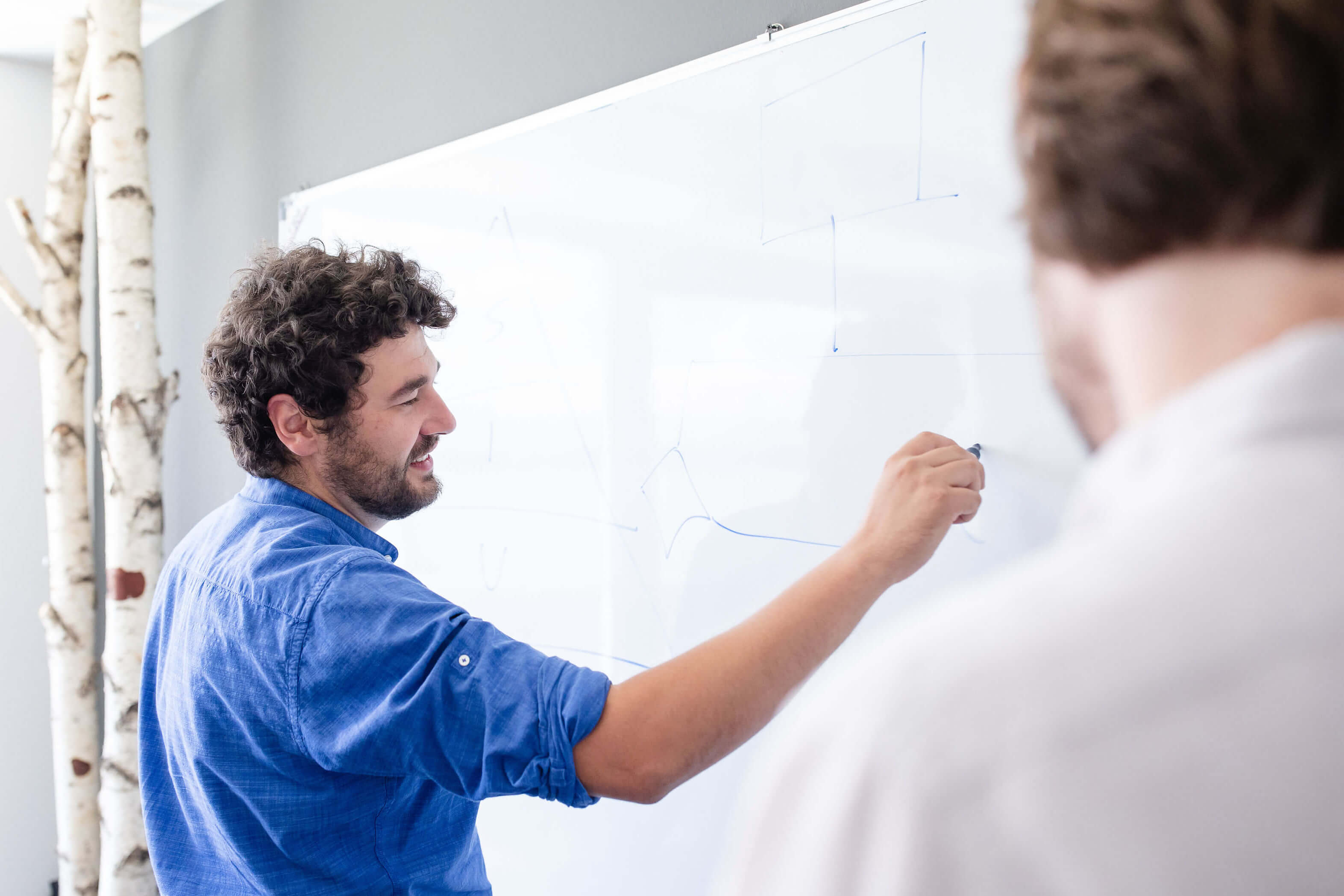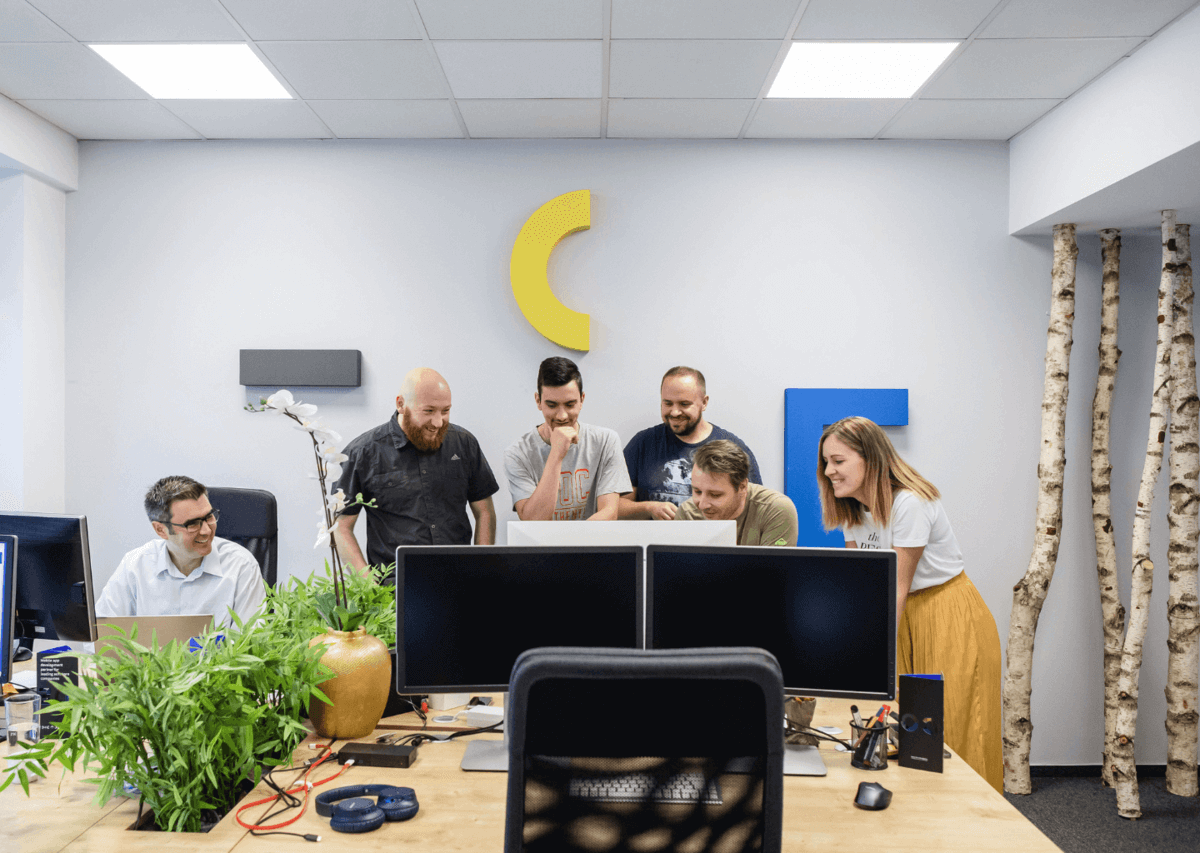There are many reasons product discovery is crucial for app success. Here, we highlighted the most important ones.
6 worst product discovery mistakes and how to avoid them
The benefits of product discovery are many.
But there are also many mistakes you can make while you’re doing it.
Not to mention the many misconceptions that surround this topic.
Don’t worry though.
We’ll dispel the misconceptions and show you how to avoid the most common mistakes in product discovery.
It also wouldn’t hurt to check out this product discovery guide so you’ll know the exact steps.
Now, without further ado, let’s check out the worst product discovery mistakes!
Table of Contents
Focusing only on your product
During product discovery, your focus shouldn’t be on your product. It should be on your target user.
Here’s a simple reason for that: No one cares about your product. They care about what your product can do for them.

The benefit matters, not the features.
A CBinsights study supports this directly. They’ve found that the 2nd reason most startups fail is that there’s no market need for them. More specifically 35% out of 111 startups since 2018 claimed that was the top reason.
Top reasons startups fail
Source: CBinsights
That means no one needed their product.
So here’s how to avoid this mistake during product discovery.
You need to define your user needs.
3 Steps to define user needs
01
Define the problem Make a market research to assume the users’ problems.
02
Hypotheses- testing Test your assumptions at user-interviews.
03
Building the product Gather all your findings and build the product.
Define the problem – First, you must identify the problem in order to solve it. That’s done through market analysis methods such as focus groups or workshops. You also need to research available solutions in the market for your assumed problem.
Test the assumption – Through user interviews and surveys you should check how the target users feel about the problem you identified in the previous step. Maybe it isn’t a problem at all, or there are different more important problems they face you could focus on.
Build the product – Wireframes and prototypes are deliverables that can help you gain much-needed feedback early in the process. Turning solutions for a problem into features can give you great actionable insights.
The importance of focusing on the user doesn’t mean you should only focus on what they want. There’s still room for creativity and innovation.
As the great Henry Ford allegedly said: “If I asked people what they wanted, they’d say faster horses.”
That said, neglecting user needs and only focusing on your product is a pitfall you should avoid during product discovery.
Not involving engineers in product discovery
Those that deliver should help discover.
Using your engineers only for solutions doesn’t give you the full value of what they can bring to the table.
You’re not in the coding business. You’re in the solving user problems business. And developers can give unique ideas when it comes to providing solutions.
Utilizing developers during product discovery can help you make more relevant features.
A 2019 report from Pendo found that 80% of features in software products are almost never used. As they focused on cloud-based software companies, Pendo also found they spent $29.5 billion on these irrelevant features.
So instead of using your resources and developers for making features no one cares about, you could use their skills in product discovery.
Not only that but giving them context from the product discovery phase of your project can prevent costly mistakes down the road. And improve your product greatly.
Source: Product discovery recipes
After all, there are 3 areas your product should cover in order to be successful:
- Value
- Usability
- Feasibility
While value and usability are responsibilities of the product owner and the designer respectively, Feasibility is the domain of the tech lead.
Source: ProductTalk
They’ll figure out whether the team can create the proposed solution based on the set resources and deadlines. The tech lead will have the knowledge and expertise needed to decide if available technologies are good enough to create the desired features.
So, not including them in product discovery would be a disaster down the road.
But how do you do it?
User interviews – When was the last time any of your developers participated in a user interview? It’s time to change that.
Including them in interviews means they could ask questions no one else will because they’ll always think about one important question: Can this solution be made?
Workshops – Analytical, problem-solving minds of developers certainly can’t hurt during product discovery workshops. Other than that, they’ll see the thought process of all other participants so they’ll understand the project better.
All in all, involving your software lead in product discovery means a more complete, balanced solution for the user.
Not involving them would be an enormous mistake.
Seeking only to validate your idea
Having a firm vision is great. Being stubborn about it isn’t.
Product discovery isn’t here to exclusively prove your assumptions right.
It’s here to help you improve or completely change your direction.
A lot of times you can see people stubbornly hold beliefs although evidence paints a different picture.
Software developers aren’t immune to confirmation bias either.
Having an idea in mind and seeking customer approval is one of the most famous professional manifestations of what cognitive scientists call confirmation bias. If you’re looking for yellow cars, you’ll end up convincing yourself that there are plenty every time you see one!
Josh Morales – Lead product researcher at Hotjar
You might look for or selectively give importance to data and evidence which supports your idea.
The reason for it is simple.
We all want to be right. It’s important to understand we can’t always be.
If you’re making a software product it’s even more important to check your biases.
When you simply hold a wrong assumption you don’t lose much by being wrong.
But investing money, manpower, and other resources into a wrong idea hurts a lot more.
So here’s how to avoid that and properly verify your idea.
Browse app store apps
By browsing popular apps in your niche you’ll see how others solved user problems and what innovative ideas they had.
You’ll also see the amount of interest they generated and that can give you an idea about what you can expect if your project is successful.
Ask users
Other than conducting user interviews I mentioned before, there’s a whole different realm you could explore to find out what people think about your idea.
The internet.
More specifically, these platforms:
Joining Facebook groups, entering relevant subreddits, or simply tweeting: “What do you guys think about X?” can yield great insights you can learn from.
Create paper wireframes
Although you’re in the early stages of validating your idea, it would still be good to create a few low-fidelity wireframes. And when I say low, I mean low.
Source: CareerFoundry
By stringing together a few paper wireframes using your early idea, you’ll be able to see whether it would make any sense. Also, you can use this essentially free deliverable to test it on users and get feedback.
Being biased about your idea during product discovery is one of the worst mistakes you can make. It can lead you to all sorts of problems, from financial to operational.
Make sure to avoid it.
Ignoring competitor research
One of the worst mistakes one can make during product discovery is to neglect to research their competition.
Here are some reasons why:
- You won’t know the trends in your niche
- You won’t know your competitors’ weaknesses
- You won’t see where you could take advantage
- You won’t gain inspiration from great competition
Other than that, market research cannot be complete without a thorough competitive analysis.
So let’s take a look at how you could do it properly.
Determine your competition – Using keyword tools such as AppTweak, you can research the keyword you want your app to rank for.
You’ll find many other solutions similar to the one you want to make.
Analyze competition users – SimilarWeb is a tool you could utilize to find out the demographics of your competitors.
You’ll find out important info about your users, such as:
- Gender
- Age
The reason to understand their users is that they’ll most likely be your users.
Source: SimilarWeb
Having done that, it’s time to look at the next step.
Analyze social media presence – You can learn a lot about your competitors by looking at their LinkedIn, Facebook, or Twitter. Here are some questions you’ll get answers to:
How do they brand themselves?
How many followers do they have?
What do they post?
By finding out answers to these questions you’ll get a better understanding of who you’re dealing with.
Identify their unique value proposition – Every business needs to stand out to succeed. You’ll need to find out your competitors’ unique advantages.
It can be anything, from great customer service to cheaper prices.
As you find out what your different competitors offer that others don’t, you can realize that you can either match their value proposition or completely blow them out of the water.
Or if you can’t reach their levels on a certain advantage, you need to find your own, that others don’t have.
Product discovery needs to have a deep competitor research and analysis. Ignoring it, or doing it shallowly would be a huge mistake.
Not making an app flow
One of the common misconceptions about product discovery is that it’s all about research. In reality, a lot of it is to do with design.
To be more specific you should be making app flows.
Why?
Because when you’re choosing features during discovery you should simultaneously be making wireframes that you’ll string together into a flow.
That way you’ll have a visual look into how features will logically flow.
If you don’t make an app flow you’ll be guessing how the structure of your app will look for a long time.
By not doing it during product discovery you stand to lose a lot of money and time.
For example, your developers could be making a feature that won’t make sense when put into a flow. It could be one feature too many which would confuse and overwhelm the user.
That means a lot of money and time wasted.
Here’s an example of an app flow:
Source: Medium
As you can see it’s a combination of wireframes completing a whole flow.
You can also make a user flow without the wireframes if you already have features in mind.
That way you’ll have an even earlier look into the whole flow of the app.
Source: anima
As you can see, this flow shows the paths a user could take as they register or login into the app. Each of the points represents a screen in the app and all the angles are covered.
The question now is: How do you make a user flow?
Know your user – As we mentioned before, understanding your user is crucial in product discovery. One of the reasons for it is to make a user flow.
By knowing what the user wants you’ll know which elements you should use in the flow.
Outline the flow – Here you should roughly define the entry points, end points, and all points in between that lead the user through the app.
Here you could differentiate the shapes of each element based on their purpose. For example:
The circle represents the process that needs to be undertaken, such as “Entry” or “Exit”.
The rectangle represents big screens such as the homepage.
The diamond usually represents a question such as “Want to register?”.
Defining element shapes gives your user flow more structure.
Refine the flow – Now’s the time to add more clarification to the elements, and think about their colors to better signify their purpose.
For example, the blue color could indicate an entire task a user could take. So when that color ends you’ll know the task is done.
Whether or not you’re using wireframes in your user flows or not, be sure to make them.
They’re a necessary part of product discovery so don’t make the mistake of not making them.
Forgetting that discovery is continuous
Here’s one of the worst product discovery mistakes you could make: Doing discovery only in the beginning.
Agile development methods are widely used throughout software development which in turn created the need for Continuous Integration and Continuous delivery (CI/CD).
But an alarming number of development teams haven’t adopted the next logical step: continuous discovery. While discovery should still be done after MVP release, many stop at initial discovery.
Being agile and changing direction shouldn’t only be applied to delivery but it should also be the case with discovery.
Here’s why:
- Constant learning
- Knowing when to drop features
- More detailed deliverables to get user feedback on
- Understanding your users better through continuous interviews
Those are just some of the benefits of continuous discovery but here’s the most important one.
As agile development allows you to adapt quickly to changing circumstances, continuous discovery tells you why to adapt and what to adapt to.
Source: AKTIA
Now all you need to figure out is how to integrate continuous discovery into your software development process.
Here are a few tips.
Create the right environment
An environment of curious people constructively questioning everything is the way to go for continuous product discovery.
When ideas get challenged egos can get hurt. By cultivating an atmosphere where ideas are separate from the people coming up with them you’ll have an easier time communicating research findings that challenge previous conceptions.
Create a product team
As we talked about earlier, you should have a trio that works on your discovery.
- A product manager
- A design lead
- A tech lead
They’ll cover all of the areas needed for effective continuous discovery.
Make discovery faster
Use tools like Hotjar to analyze how your early users are interacting with your app. You’ll save a lot of time by not having to observe your users.
Also, schedule your user interviews regularly every week so as not to get sidetracked by other assignments.
To conclude: Product discovery is never over. Don’t make the mistake of thinking it is.
Product discovery mistakes: Final word
It’s easy to make mistakes during product discovery. Let’s summarize the worst ones:
- Focusing only on your product
- Not involving engineers in product discovery
- Seeking only to validate your idea
- Ignoring competitor research
- Not making an app flow
- Forgetting that discovery is continuous
Hopefully, by making you aware of these mistakes you’ll be less likely to make them.
The advice we gave you should be useful too.
If you still find the whole process of product discovery intimidating, or simply too time-consuming, no worries.
Our product team specializes in product discovery that results in products that fit the market and serve users in the best possible way. Feel free to check out our process!



